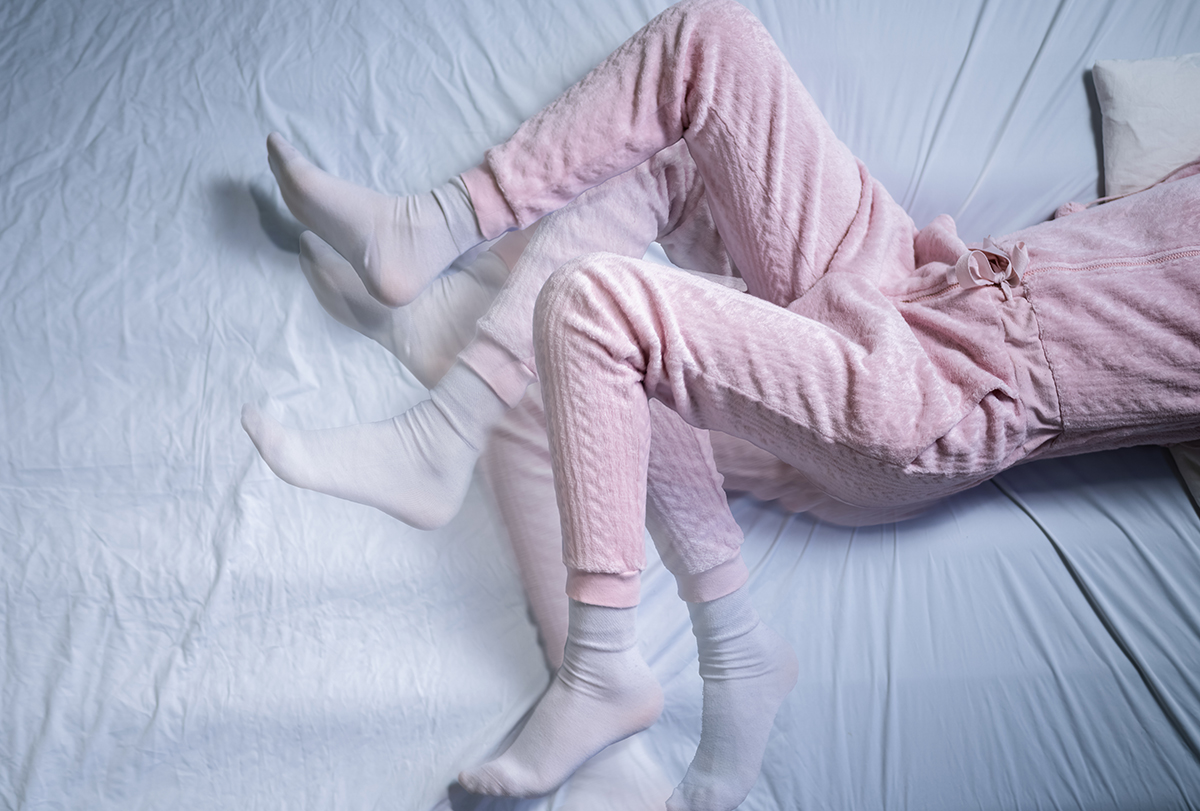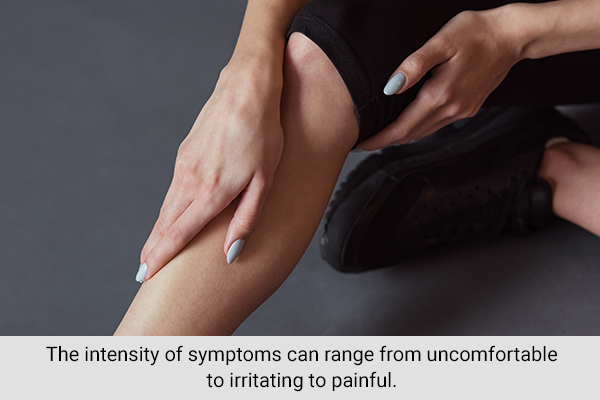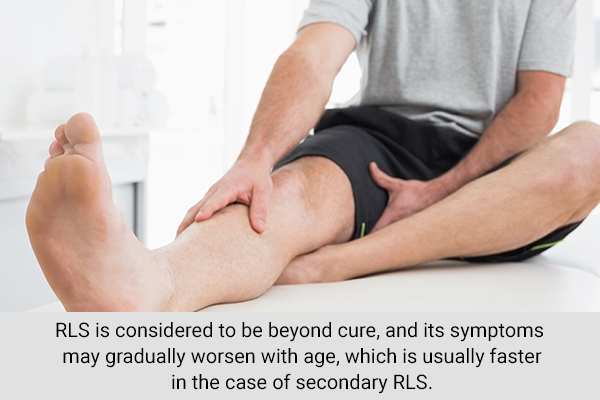In this article:
Do you experience persistent sensations in your legs that keep you awake at night? Even when the rest of your body is aching to fall into a state of deep sleep, you are repeatedly overcome by this need to keep moving your legs, tossing and turning until the break of dawn.

What makes this condition even more frustrating is that it is often shrugged off by those not suffering from it with a casual “it’s all in your head.”
Rest assured (no pun intended) that this seemingly strange condition is not psychosomatic. You may very well be afflicted by what is known as restless legs syndrome (RLS), a neurological disorder affecting an estimated 12 million Americans.
Causes and Types of Restless Legs Syndrome
The exact cause of restless legs syndrome is unidentified. However, it is sometimes associated with several medical conditions.
There are basically two types of restless legs syndrome: (1)
Primary restless legs syndrome
Primary restless legs syndrome is the most common form of restless legs syndrome and is also called idiopathic restless legs syndrome because the exact cause of the disease remains unknown. It is, however, characterized by some common features: (2)(3)
- It’s more prevalent in younger people and the symptoms usually start to set in before the age of 40, sometimes even during childhood.
- It’s sometimes hereditary in nature and usually runs in the family.
- Symptoms can be intermittent or progress and worsen gradually.
- Primary restless legs syndrome is a lifelong condition, which can only be managed but not cured.
Secondary restless legs syndrome
Secondary restless legs syndrome is a result of some separate underlying medical condition. It’s sometimes triggered by the use of certain drugs in some patients. The common features of secondary restless legs syndrome are as follows:
- The onset of this type of restless legs syndrome usually begins later in life, after the age of 45, and it’s not generally hereditary in nature.
- Its occurrence can be sudden and more severe in nature.
- The symptoms may disappear once the underlying medical condition is treated.
- Iron deficiency and pregnancy are known to be the major causes of secondary restless legs syndrome. (4)
Other conditions known to cause the disease are:
- Obesity, smoking, and diabetes
- Kidney failure (5)
- High blood pressure and heart disease
- Parkinson’s disease (6)
- Thyroid dysfunction
- Autoimmune disease, peripheral neuropathy
- Alcohol or opioid withdrawal (7)
- Medications including certain antihistamines, antipsychotics, antidepressants, (8) anticonvulsants, and anti-nausea drugs, are known to trigger or worsen the symptoms of restless legs syndrome.
Signs and Symptoms of Restless Legs Syndrome

- Symptoms of restless legs syndrome come to the fore when the patient is in a position of rest. They tend to fluctuate in severity and are at their worst during the evening, especially with the onset of sleep.
- An irresistible urge to move the legs following unpleasant sensations such as throbbing, pulling, creeping, tingling, or strange crawling feeling in the legs are the hallmark symptoms of this disorder. (9)
- The intensity of these symptoms can range from uncomfortable to irritating to painful.
- There is persistent restlessness or urge to move in order to relieve the discomfort temporarily.
- The symptoms tend to get better during the daytime and might even disappear altogether.
- Long periods of inactivity or restrictive movement of the limbs due to confined space such as long flights, sitting in a movie theatre or in front of the TV, car trips, or immobilization due to a cast can also trigger the symptoms.
- The persistent discomfort at night causes sleep deprivation, which in turn results in exhaustion, daytime fatigue, and higher rates of anxiety or depression in patients suffering from restless legs syndrome.
- Although these symptoms generally manifest themselves deep inside the leg, between the knee, and in the ankle, they can occur in the feet, thighs, arms, and hands as well.
- Furthermore, this condition most often afflicts both sides of the body rather than just one side.
- The symptoms may subside or show marked improvement during the initial stages of the disorder, but they will eventually reappear and exacerbate over time.
Diagnosis of Restless Legs Syndrome
Diagnosis of restless legs syndrome is largely based on the presence of restless legs syndrome symptoms and ruling out other medical conditions.
Results of a physical and neurological exam, the symptoms described by the patients, and their sleep patterns, medical history, family background, travel history, and lifestyle give crucial clues to the General Practitioner (GP).
The GP will assess the patient for the signs and symptoms of some other underlying medical conditions causing the issues. Certain blood tests are done to rule out pregnancy, kidney failure, diabetes, or anemia.
Restless Legs Syndrome Prognosis

Restless legs syndrome is considered to be beyond cure, and its symptoms may gradually worsen with age, which is usually faster in the case of secondary restless legs syndrome.
Because secondary restless legs syndrome is often traced back to some other medical conditions, current treatments more or less focus on treating the underlying disorder and managing the symptoms to improve the quality and duration of sleep.
In some patients, remissions were reported, where the symptoms disappeared for days or even months but eventually reappeared.
Risk Factors Associated With Restless Legs Syndrome
- Restless legs syndrome affects people of all ages, and usually, deteriorates with age.
- Women appear to be more susceptible to restless legs syndrome than men.
- Although the disease affects the person psychologically, it is not a serious disease itself.
- Restless legs syndrome is often indicative of some ongoing abnormal or serious latent medical condition such as diabetes, end-stage kidney disorder, anemia, and spinal cord injury.
When to See a Doctor
People suffering from restless legs syndrome often underestimate their symptoms and avoid visiting the GP. The condition continues to worsen over time to a stage when managing it becomes increasingly difficult.
Sleep deprivation and the resulting exhaustion, anxiety, and depression can have long-standing effects on the quality of the affected person’s life. Moreover, restless legs syndrome is often rooted in some underlying medical condition that might be serious.
Thus, it’s always a good idea to consult with your healthcare provider if you have symptoms of restless leg syndrome, especially if you are over 45.
Final Word
There is no cure for restless legs syndrome but it can be managed through proper treatment and proactive home care. Early diagnosis and treatment is the best way to minimize the severity of the condition so that it remains easy to control.
Conversely, if you delay treatment, the condition will only get worse with age to the point of becoming unmanageable and increase the risk of undue complications. So, if you experience any symptoms associated with restless legs syndrome, consult your doctor who will guide you in the appropriate direction.

- Was this article helpful?
- YES, THANKS!NOT REALLY


